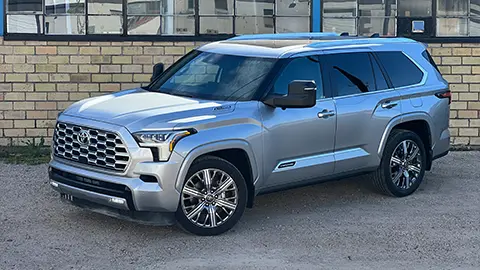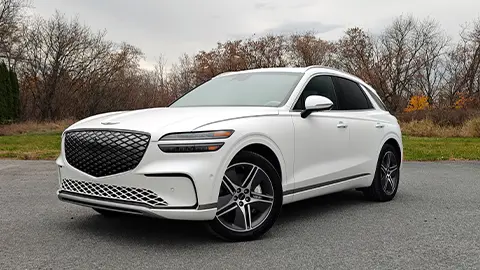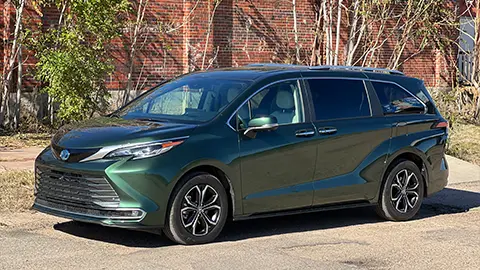2024 Porsche Taycan GTS Sport Turismo: Amazing Electric All-Rounder
Four years ago, when Porsche first introduced the Taycan, I wasn’t prepared to like it. As an old-school fan of the brand, I was nervous about its size, its weight, and most importantly, its electric power. How could the brand replicate the driving excitement of its gasoline sports cars with an EV? Well, it turns out Porsche could, and they did so with a spectacular-looking four-door that was one of the most innovative EVs on the market.
Now, the Taycan is not just an EV, it is a whole range of EVs, with starting MSRPs ranging from $90,900 to $197,500, a choice of rear- or all-wheel drive, a variety of power outputs, and even three body styles: sedan, Cross Turismo, and Sport Turismo. The latter two, which could basically be called wagons, are all-wheel drive only, and today, we’re trying out the Taycan GTS Sport Turismo.
Taycan GTS: Design and Practicality
Unlike other Taycan wagon models, which are sold under the name “Cross Turismo,” the GTS version is sold as a “Sport Turismo.” Mostly, that means that the GTS model lacks the off-road-ish body cladding of the other long-roof Taycan models, and its ride height is also about a half-inch lower as a default. Shorn of the body cladding, and rolling on gorgeous 20- or 21-inch wheels, the GTS Sport Turismo looks like a concept car – sleek and futuristic and with nearly unbelievable proportions.
Like all Taycan models, the GTS Sport Turismo is very wide and very long – so much so that in the city, and in underground parking lots, you’re always conscious of its size. On the other hand, the car’s large footprint gives it a spacious interior and that wagon body also makes the cargo area more practical. Rear-seat room is unchanged from the Taycan sedan, meaning that there’s decent room to stretch out, and “foot garages” carved out of the large battery in the floor make for a more comfortable seating experience.
While there actually isn’t a lot more room than there is in the sedan, access to the cargo area is significantly easier: the regular Taycan’s trunk is accessed through a skinny slot that makes it difficult to load large items, while the Sport Turismo’s hatch opens nice and wide, making it much easier to load bulky objects, whether that’s ski gear or flat-pack furniture. The floor is nice and flat, if a bit higher than you might expect, and the hatch is powered for convenience; there’s also a second trunk in the front of the car for smaller bags.

Sport Turismo Interior
Inside the cabin, you’re treated to a combination of the usual Porsche virtues along with some futuristic technology. It’s easy to get the 18-way power driver’s seat low just like in a 911, and the seat itself is supremely comfortable, directly in line with the pedals and the steering wheel. Visibility is terrific out the front and sides, the road framed by the curved fenders. And while there isn’t a lot of glitz in the interior – you won’t find chrome, or wood, or other fancy finishes in here – the quality of the materials is amazing, and the build quality is solid.
For the 2023 model year, Porsche launched a major update to its all-touchscreen infotainment system, significantly improving its speed and ease-of use. Major functions are now color-coded to make it easier to find the controls you are looking for, and the interface is much more reminiscent of a smartphone, and much easier to use while on the go. Apple Music is built into the new infotainment system, as is wireless CarPlay and Android Auto.
While the response time of the touch panels – there’s one for the infotainment system on the dash, one for the climate control on the console, and an optional third screen for passengers – is adequate, and the logic much improved, I still found the tech-fest slightly frustrating to use on the go. While the drive modes are easily selectable with a knob on the steering wheel, every other setting requires wading through menus to find settings. Switching audio sources requires multiple taps and swipes, and the climate control touch panel requires a firmer touch than the other screens.
One optional feature that we absolutely love is the Taycan’s variable electrochromic glass roof. A giant glass panel with embedded wiring, the roof can be transparent or opaque on demand, and you can even activate artistic patterns in the roof to vary the amount of light coming into the cabin. Like all of the screens, it’s a reminder that you’re driving something that’s beamed in out of the future.

Porsche Taycan GTS Driving Experience
Within Porsche’s Taycan lineup, the 590-hp GTS ($141,200 starting MSRP for the Sport Turismo; $139,300 for the sedan) is sort of the “goldilocks” option. With standard all-wheel drive, in terms of power and performance, it sits between the 522-hp Taycan 4S ($111,700 starting MSRP) and the 670-hp Taycan Turbo ($160,800 starting MSRP).
In fact, the GTS model combines the front electric motor from the 4S model and the more powerful rear electric motor from the Taycan Turbo, to produce a 0-60 mph time of just 3.5 seconds. Porsche’s Sport Chrono package, which gives you an analog stopwatch, that rotary drive-mode selector, and a Sport Plus mode, tightens up the air suspension and provides launch control for when you need the most performance. And there’s also an enhanced “electric sport sound” that you can turn on that adds a bit of emotion to the driving experience.
Like all Porsches, gasoline or electric, and especially its GTS models, the Taycan Sport Turismo’s suspension delivers exceptional responsiveness and body control without sacrificing ride quality. With standard four-corner air suspension, just like the Turbo models, you can choose from soft to super-stiff settings, but even the sportiest setup is comfortable enough to use on a daily basis. There’s also superb steering feel, and a real sense of confidence in the corners. While there’s no doubt at any time that you’re behind the wheel of a very heavy car, the GTS is easy to drive fast on a flowing road, thanks to standard electric torque vectoring and the traction provided by the all-wheel drive.
Acceleration, of course, is uncomfortably fast. Unlike most EVs, which rely on a single-speed transmission, the rear axle of the Taycan actually has a two-speed transmission that gives it extra grunt from a standing start while providing more efficient running on the highway. It’s hard to imagine why anyone would need or want even more speed or power, which come with the Turbo and Turbo S models – particularly since the extra performance comes at the expense of some range.

Porsche Taycan GTS: Range and Charging
Estimated by the EPA at 246 miles, the Taycan GTS Sport Turismo’s range is far from class-leading when you consider its 93.4-kWh battery size. Introduced in early 2020, the Taycan was one of the first mainstream luxury EVs, and battery efficiency has moved on a bit since its introduction. Newer high-performance models from Mercedes-Benz and BMW (not to mention the stalwart Tesla Model S) deliver higher EPA estimates, but what’s impressive about the Taycan is how it can consistently beat the EPA range estimates.
Indeed, AMCI, an independent U.S. testing institute, regularly found that the Taycan regularly outperforms EPA estimates, even if the absolute totals aren’t that high. In real-world driving, I found that the range estimator was very accurate. Unlike some other EVs, high-speed freeway cruising doesn’t have a huge effect on range, thanks to the two-speed transmission, and the way the GTS “freewheels” at high speeds instead of aggressively regenerating. Of course, should you wish, a switch on the steering wheel activates more aggressive regen, or an automatic mode that regenerates to maintain a safe distance from the car in front, and even takes into account traffic patterns from the navigation system.
The more time I spend with electric vehicles, the less anxiety I have about charging, as well. Public charging infrastructure has improved significantly, and even without charging available at home in my apartment’s parking spot, finding a Level 2 charger close by to fill up overnight was easy. Indeed, in a week’s worth of driving, I never used an expensive Level 3 fast charger – meaning my charging costs, even on public chargers, were less than a fifth of what I’d have spent on gasoline. A dedicated home charger would have been even cheaper, and the Taycan can also charge at up to 19.2 kW on a Level 2 charger – twice the speed of most EVs.
Of course, consumers considering a $140,000-plus Porsche likely aren’t going to be that worried about charging costs, though the savings is a really nice bonus. What they will appreciate is that, equipped with home charging in their garage, they’ll be able to leave home with a full tank of electrons every morning, and generally won’t have to worry about range at all. And when they do occasionally take a long trip, the Taycan’s 800-volt architecture and 270-kW Level 3 charging capability make it one of the fastest-charging EVs on the market. Just like it’s one of the fastest EVs, period.
Porsche Taycan GTS: Conclusion
Now four years old, the Taycan is still one of the best-looking, best-driving, and most appealing electric vehicles on the market. But while its performance and driving experience are exceptional, its overall range and efficiency are no longer class-leading – an indication of just how far EV technology has progressed in a very short time. Like all Porsche models, it is also not cheap, and expensive but desirable options can inflate its high base price even further. The latest Porsche models also have integrated some physical controls along with the touchscreens for greater ease of use.
But, if you’re set up to charge at home, and can afford the cost of entry, there’s little on the market today that delivers the Taycan’s combination of style, performance, and technology. The Taycan GTS Sport Turismo, with its more versatile wagon body, is the best model in a diverse lineup, with a great driving experience as well as the most stylish look.
Next year, Porsche will be introducing a fully-electric version of the Macan, its best-selling model, as well as an electric 718 sports car. Using the latest generation of battery tech, and priced much lower than the Taycan, they will bring the electric Porsche experience within reach of many more driving enthusiasts – even those who also have families and gear to haul. Based on our experience with the Taycan GTS, the new Porsche EVs are going to be amazing.
















